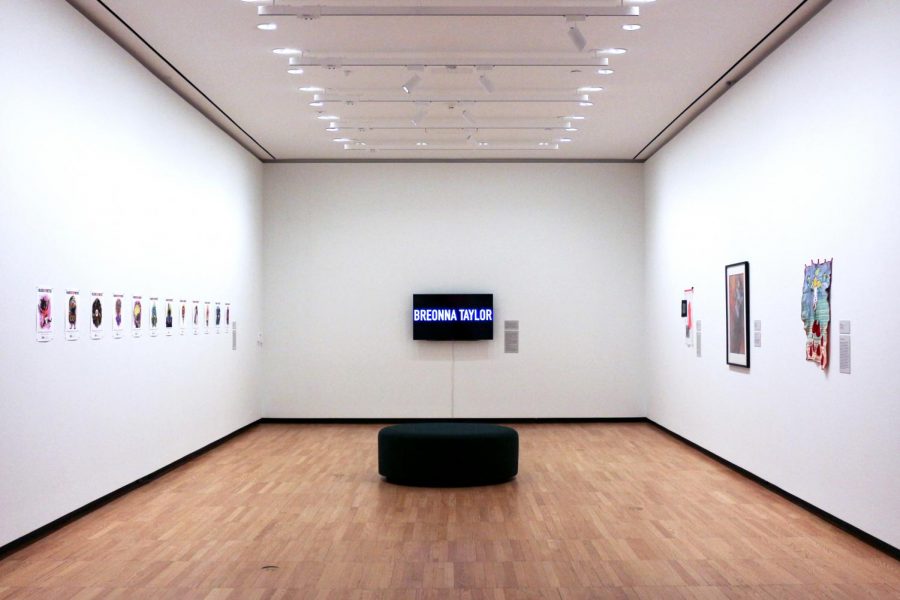BLM exhibit comes to Krannert Art Museum
Photo Courtesy of Stacey Robinson
The #BLACKMATTERS art installation stands inside the Krannert Art Museum on Thursday. The installation was created by Stacey Robinson and John Jennings to emphasize the importance of Black lives.
Apr 1, 2021
As you walk into the faculty art exhibit at the Krannert Art Museum there lies a wall displaying art prints with incredible detail and various #BLACKMATTERS phrases. Stacey Robinson, professor in LAS, created a series of art pieces with his collaborative partner John Jennings to capture the components of Black lives that he said might be overlooked. On that wall are 12 pieces, ranging from #BLACKJOYMATTERS to #BLACKEDUCATIONMATTERS and #BLACKPOWERMATTERS.
“John and I have been collaborating since 2012, and we collaborate on a number of different projects; our moniker is Black Kirby,” Robinson said.
What originally started as a commission of billboards for the Contemporary Photography & Visual Arts Gallery in Buffalo, New York, to represent the summer of 2020, have now become art prints for the faculty exhibit at the Krannert Art Museum.
“Those pieces that are in Krannert were originally made to be billboards, ” Robinson said. “The pieces you see are the prints that were made as a fundraiser, and a portion of them went to charity.”
Each art print shows a different message for Black Kirby. For #BLACKLOVEMATTERS, Robinson decided to represent this unconventionally.
“When I thought about love, I wanted to show a person by themselves, because in quarantine we are away from our loved ones, sometimes by ourselves,” Robinson said. “I needed to learn how to love myself in a very interesting way that Black women taught me how to do, so I wanted to make (#BLACKLOVEMATTERS) to address that.”
Robinson has done work surrounding social issues, particularly with Black activism, for years. This year was no different. He said that his work has always been about these issues, and it’s not like anything new happened this summer that hasn’t already been happening in this country for hundreds of years.
The original use of billboards juxtaposes the current art prints at a museum. With billboards, artists are limited on what words they can include because many people only see them for a few seconds.
Robinson said that if someone was driving by the original billboards, you may only be able to take in the text. As a result, he made sure the text was very easy to read with a clean typeface. The hashtag was broken up, where the “black” and “matters” were in black text.
“I tried to choose colors that were the most vibrant, stood out the most and allowed people to read it if they were driving by,” Robinson said.
The art school has facilitated a faculty exhibit for the past 95 years, way before the existence of the Krannert Art Museum. Since its inception, the faculty has filled the exhibit with contemporary art pieces that represent key sentiments of the time.
Julia Nucci Kelly, assistant director for Marketing and Communications of the Krannert Art Museum, said contemporary art often engages the most important issues of the day. These are artists working in their studios, but they are also artists living in the world at the same time, using art as a way to express something important.
This is no different with Robinson’s #BLACKMATTERS art installation and various other pieces in the faculty exhibit. Many faculty members created pieces to serve as a reminder to the social activism of Black Lives Matter.
The museum put individual art pieces that reflected on particular themes close by each other when thinking about the visitor experience.
The social responsibility of artists has always been strong, not only in the art community here, but in many places, Kelly said. Artists often bring new perspectives to activism, with how Robinson and Jennings decided to portray the positive components that make up Black Lives Matter in a format that engaged viewers in both Buffalo, New York and Champaign, Illinois.
“You want someone to come in and be able to make the connection between what one artist is doing, and another artist is doing,” Kelly said. “But, we also want to give each artist work in that space to be considered on its own. So, Stacey Robinson’s work is in a line along that wall and he does not have to share that space with anyone else.”
The piece is on display at the Krannert Art Museum until April 24.






